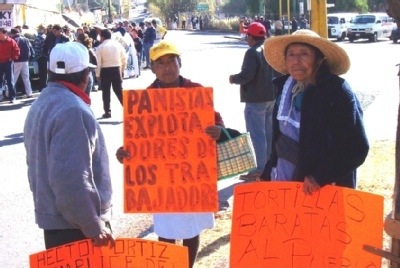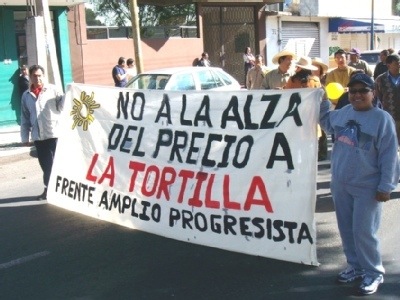Supply and Demand in Mexico: Rises in Staple Prices Rile the Population
Editor’s note: As debate over Mexico’s economic policies is happening at the highest levels of the government, peasants took to the streets over the price of tortillas. Even the New York Times is taking notice. Today, the Times reported:“Tens of thousands of workers and farmers filled this city’s central square on Wednesday to protest spiraling food prices, ratcheting up the volume over a problem that has dogged President Felipe Calderón in his first weeks in office.”And for what might be the first time ever, the NYT explained that what protesters are asking for is food sovereignty. We are thrilled that a national newspaper is taking notice of this growing fight for policies that do not undermine local, national and global food systems.Two close Grassroots International advisors, Marie Kennedy and Chris Tilly, are on the ground in Mexico. They have sent us this first of many reports to come, and we are excited to be able to share them with you here.
The last year has been a fractious one in Mexico. Last May, in San Salvador Atenco in Mexico State, a group of street vendors and a wide range of allies protesting expulsion from the central square were brutally repressed, with hundreds arrested, beaten, and sexually abused by police. To the south in Oaxaca, Governor Ulises Ruiz launched a similar police operation against striking teachers in June, sparking the formation of a broad front that occupied the center of the city for months despite constant attacks by police and armed goons, only to be swept out in November by a vicious federal-state police assault. Meanwhile, as the every-six-years presidential campaign heated up, a caravan of Zapatistas headed by Sub-comandante Marcos toured the country arguing that only grassroots mobilization, not a vote for one of the three major-party candidates, would change Mexican politics. July’s presidential election put the right-wing National Action Party (PAN) candidate, Felipe Calderón, ahead of the center-left Party of the Democratic Revolution’s (PRD) Andrés Manuel López Obrador (popularly known as AMLO) by a razor-thin margin, amid evidence of large-scale irregularities. AMLO’s supporters took to the streets, creating a festive tent city stretching miles along Mexico City’s main boulevard, La Reforma, and coming together in animated rallies of up to two million. Failing to change the election result, they declared a parallel government.
In January 2007, all of these struggles have been heating up once again. Key Atenco leaders are getting out of jail. Activists are marching in Oaxaca city once again, and a major Triqui indigenous community in that state just declared itself autonomous from the state, federal, and “official” local governments. AMLO and allies across the country are gearing up what they call the Democratic National Convention, with the aim of building a new politics and writing a new Constitution. The Zapatistas unfurled an Encounter with the Peoples of the World, hosting 2000 delegates in their base communities. And across Mexico, the hot topic of the moment is…
…the price of tortillas. Prices for this Mexican staple, just a few months ago selling at 5 pesos (about 50 cents) per kilo (2.2 pounds, about 40 tortillas), had by mid-January spiked up to 8, 10, and in some places even 12 or 15 pesos per kilo. It’s hard to convey to a U.S. audience how central tortillas are to the Mexican diet, but suffice it to say that tortillerías are sprinkled every couple of blocks across urban Mexico, and the great majority of families anchor their main meal with a kilo or two of tortillas. (When we first went to a tortillería and asked for ten tortillas, the vendor assumed she had heard us wrong and asked, “Ten kilos?”) Perhaps the closest U.S. equivalent in terms of breadth of impact would be if the price of gas doubled and in some places even tripled. Other prices are also climbing—milk, eggs, sugar, meat, and natural gas—but it’s the tortilla price surge that has grabbed Mexicans by the throat.

A number of things are odd about the tortilla crisis. For one thing, there is no shortage of corn. Mexico had the largest corn harvest ever last year, more than twice as much as in 1980 (the country’s population grew about 60% over that same period). However, the structure of corn production has changed dramatically. Hundreds of thousands of family farmers in central and southern Mexico once dominated the crop; today, northern Mexican agribusiness calls the tune. That plus NAFTA and other free trade agreements and the reduction of government subsidies mean that Mexico’s corn price is now the world price (which increasingly responds to demand for ethanol as well as for food products). In addition, observers including the President of Mexico’s Central Bank argue that speculation by large producers and traders is driving prices upward.
Another oddity is the spectacle of a newly elected, pro-free trade president suddenly discovering the virtues of government intervention in the economy. President Calderón speedily negotiated an 8.5 peso cap with major corn meal and tortilla producers and retailers, promising to boost corn supplies so as to underwrite this price and stock the 24,000-odd government-run rural DICONSA stores that sell staples at subsidized prices. Ironically, he’s increasing the supply by importing corn from the U.S.
Of course, once the price agreement was concluded, the tortilla industry began backing away from it. The corn meal giants clarified that this was a goodwill gesture on their part, not an ironclad commitment. Spokespeople for neighborhood tortillerías pointed out that they didn’t work for the big companies, so the agreement wasn’t binding on them. A few days after Calderón’s tortilla handshake, we spot-checked tortillas in Tlaxcala (central Mexico, where we are living for six months)—the two tortillerías we priced were both selling at 9. That same day, the state government of Tlaxcala announced with much fanfare that it had concluded a separate 8.5 peso agreement with tortillerías. So the next day we returned to the same two shops: one was closed (we stopped by too late); the other was still charging 9…. Around the same time, federal government inspectors found prices over 8.50 at 53% of the tortillerías visited nationwide. Still, two weeks after Calderón’s pact, federal authorities had only managed to check prices at just over 3000 shops, out of 75,000. On the other hand, the country’s giant supermarket chains, including Wal-Mart, made a big show of discounting tortillas to 5 or 6 pesos (as a visit to our local Wal-Mart confirmed). Not a fair comparison, declared the tortillería industry: they mix all kinds of non-corn filler into their nixtamal, and besides, Mexicans prefer their tortillas fresh, hot, and local off a neighborhood comal (griddle).

Naturally, Calderon’s critics were not satisfied with his attempt to pull the tortillas out of the fire. AMLO and the PRD called for a 6-peso ceiling on tortilla prices and a 35% increase in the minimum wage (currently set at a laughably low $5 U.S. a day). Not to be outdone, the Confederation of Revolutionary Workers and Peasants (CROC—despite its fiery name, a mainstream union federation long affiliated with the Institutional Revolutionary Party [PRI] that ruled Mexico for seventy years but has now slipped to third place) demanded price ceilings on 30 items of the canasta básica (the basket of basic consumer necessities tracked by the government). On January 31, these groups and more organized a megamarcha to protest the growing gap between prices and wages. Left-leaning daily La Jornada described the turnout in Mexico City as “tens of thousands”—numerically disappointing compared to other recent demonstrations—but what was particularly significant was the presence of activists from the PRI, two smaller parties, and a large number of worker and peasant organizations that had not previously joined PRD-led mobilizations. We had to miss the Tlaxcala branch of the action (it took place at the same time as the class we’re teaching), but we joined a smaller pre-march the Saturday before (see photos). A cheerful crowd of a couple of hundred, including a large contingent from the local chapter of the Social Security Administration union, rallied to slogans like, “No to PAN [both the name of the ruling party and the word for bread], yes to tortillas!” José Roberto Pérez Luna, Secretary of the union, told us, “The system is not meeting the needs of the majority. That’s what leads to revolutions. I’d hate to think that our government is fertilizing a revolution.”
Pérez Luna is right. Whatever happens next with tortilla prices, the issues of the widening gap between most Mexicans’ salaries and the cost of living, and the other widening gap between the rich and the rest, are not going away. These are some of the same issues that fueled the Zapatista rebellion, the street vendors’ protest in Atenco, the teachers’ strike in Oaxaca, and the wave of anger at the elite that has made AMLO’s protests much more than the sour grapes of a losing candidate. Calderón’s strategy—continued free market reforms sprinkled with crowd-pleasing tactical concessions like the tortilla pact, and the mailed fist for protestors (“In this country, we will no longer confuse illegality with human rights,” he remarked recently in a not-very-veiled warning)—seems more likely to accelerate these trends than halt them. In the coming years, expect Mexican politics to heat up as hot as a tortilleria’s comal.
Donate to Grassroots International’s human rights work in Oaxaca.
Marie Kennedy and Chris Tilly are spending six months based at the Colegio de Tlaxcala in Mexico. Both are members of Grassroots International’s Advisory Board, and Tilly is a Dollars & Sense Associate. Kennedy is professor emerita of Community Planning at the University of Massachusetts Boston, and Tilly is professor of Regional Economic and Social Development at the University of Massachusetts Lowell. You can reach them at marie.kennedy@UMB.edu and chris_tilly@UML.edu.
